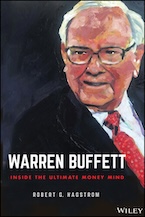Book Summary of Warren Buffet- Inside the Ultimate Money Mind
by Robert G. Hagstrom

What is this book about?
The book "Warren Buffett: Inside the Ultimate Money Mind" by Robert G. Hagstrom explores the mindset, philosophy, and principles that have guided Warren Buffett's successful investment strategies over the years. The book delves into what Hagstrom terms the "Money Mind," a particular way of thinking about investment and capital allocation that Buffett has mastered. The author also traces the evolution of Buffett’s investment philosophy, drawing on the influences of key figures like Benjamin Graham and Charlie Munger, and explores how Buffett’s unique mindset has been crucial to his success.
Who should read the book?
This book is ideal for:
- Investors and finance professionals who want to understand Warren Buffett’s investment philosophy in depth.
- Business students and academics studying finance and investment strategies.
- Individuals interested in behavioral finance and the psychology behind successful investing.
- Readers who are fans of Warren Buffett and wish to learn more about his approach to business and life.
10 Big Ideas from the Book
- Money Mind Concept: A central idea in the book is the "Money Mind," which emphasizes the importance of temperament and mindset in successful investing, beyond just knowledge and analytical skills.
- Long-Term Thinking: Buffett’s strategy involves a long-term perspective, focusing on the compounding of wealth over decades rather than short-term gains.
- Value Investing: The book covers Buffett’s adherence to value investing principles, seeking undervalued companies with strong potential for growth.
- Investment in People: Buffett believes in the importance of investing in businesses with strong leadership and ethical management.
- Simplicity and Clarity: Buffett’s investment decisions are guided by simplicity and clarity, avoiding complex strategies that he doesn’t fully understand.
- Rationalism and Pragmatism: These philosophical approaches influence Buffett’s decision-making, focusing on practical and logical investment strategies.
- Capital Allocation: Effective capital allocation is crucial, and Buffett’s ability to allocate capital efficiently is highlighted as a key factor in his success.
- Temperament Over IQ: Buffett argues that a high IQ is less important than having the right temperament for making sound investment decisions.
- The Role of Patience: Patience is a virtue in investing, and Buffett’s success is attributed to his willingness to wait for the right opportunities.
- Influence of Key Figures: The book discusses how mentors like Benjamin Graham and Charlie Munger have shaped Buffett’s approach to investing.
Summary of "Warren Buffett: Inside the Ultimate Money Mind"
Overview: "Warren Buffett: Inside the Ultimate Money Mind" by Robert G. Hagstrom offers an in-depth exploration of the mental framework that has guided Warren Buffett throughout his illustrious investment career. The book does not merely recount Buffett's strategies but delves into the philosophical underpinnings and psychological traits that define his unique "Money Mind." Hagstrom traces Buffett's intellectual journey from his early influences, particularly Benjamin Graham, to the development of his own investment philosophy. The book is structured to provide readers with an understanding of how Buffett thinks about money, investment, and business, offering insights that can be applied to personal and professional financial decision-making.
Key Insights:
-
The Concept of the "Money Mind":
- Definition: The "Money Mind" refers to a mindset that combines rationality, emotional control, and a deep understanding of economic and business fundamentals. It is a way of thinking that prioritizes long-term wealth creation over short-term gains.
- Significance: This concept is crucial because it emphasizes that successful investing is as much about temperament and mindset as it is about technical knowledge.
-
Value Investing:
- Definition: Value investing involves buying securities that appear underpriced by some form of fundamental analysis. Buffett's value investing approach is deeply influenced by Benjamin Graham, who advocated for purchasing stocks at a discount to their intrinsic value.
- Significance: This principle forms the bedrock of Buffett’s investment philosophy. It underscores the importance of patience and discipline in waiting for the right opportunities to buy undervalued assets.
-
Long-Term Thinking:
- Definition: Buffett’s investment strategy is characterized by a long-term outlook, focusing on businesses that will grow and compound value over decades.
- Significance: The emphasis on long-term thinking is crucial in avoiding the pitfalls of market volatility and short-term speculative behavior, which can lead to poor investment decisions.
-
The Importance of Rationalism and Pragmatism:
- Definition: Rationalism involves making decisions based on logical reasoning and factual evidence, while pragmatism emphasizes practical solutions and results.
- Significance: These philosophies guide Buffett in making sound investment decisions that are not swayed by market sentiment or emotional biases.
-
Capital Allocation:
- Definition: Capital allocation refers to the process of deciding where and how to invest resources to generate the best returns. Buffett's skill in capital allocation is a major factor in his success.
- Significance: Efficient capital allocation allows investors to maximize returns by investing in high-quality businesses and avoiding those with poor prospects.
-
Investment in Quality Management:
- Definition: Buffett places significant importance on the quality of a company’s management team, preferring to invest in businesses run by ethical, competent, and shareholder-friendly leaders.
- Significance: Good management can significantly enhance a company’s performance and shareholder value, making it a critical factor in investment decisions.
-
Simplicity and Focus:
- Definition: Buffett advocates for focusing on simple, understandable businesses and avoiding complex investments that are difficult to evaluate.
- Significance: This approach minimizes risk and enhances the ability to make informed decisions based on a clear understanding of the business.
-
The Role of Patience:
- Definition: Patience in investing means waiting for the right opportunities and not rushing into decisions based on short-term market movements.
- Significance: Patience is a key trait of successful investors, allowing them to take advantage of opportunities when they present themselves rather than forcing investments in unfavorable conditions.
-
The Influence of Key Mentors:
- Definition: Buffett’s investment philosophy was shaped by mentors like Benjamin Graham and Charlie Munger, who emphasized the importance of value investing, rational decision-making, and ethical business practices.
- Significance: Understanding the influence of these mentors provides insight into the development of Buffett’s unique approach to investing.
-
Behavioral Finance Insights:
- Definition: Behavioral finance examines how psychological factors influence investor behavior and decision-making. Buffett's success is partly attributed to his ability to control emotions and avoid common behavioral pitfalls.
- Significance: By mastering the psychological aspects of investing, Buffett has been able to consistently make rational decisions that others might miss due to emotional biases.
Relevant Metrics and Key Concepts to Remember
-
Intrinsic Value:
- Definition: The intrinsic value of a company is the actual worth of the company based on its fundamentals, including earnings, dividends, and growth potential, rather than its current market price.
- Significance: Understanding and calculating intrinsic value is essential for value investing, allowing investors to buy stocks at a discount to their true worth.
-
Margin of Safety:
- Definition: This concept, introduced by Benjamin Graham, involves buying securities at a significant discount to their intrinsic value to protect against errors in analysis or market downturns.
- Significance: The margin of safety is a cornerstone of conservative investment strategies, providing a buffer against risk.
-
Compound Interest:
- Definition: Compounding involves reinvesting earnings to generate more earnings over time, creating exponential growth.
- Significance: The power of compounding is a fundamental principle in Buffett’s investment strategy, highlighting the benefits of long-term investing.
-
Return on Equity (ROE):
- Definition: ROE measures a company's profitability by showing how much profit it generates with the money shareholders have invested.
- Significance: A high ROE indicates efficient use of investor capital, making it a key metric in assessing the quality of a business.
-
Debt-to-Equity Ratio:
- Definition: This ratio measures the relative proportion of shareholders' equity and debt used to finance a company’s assets.
- Significance: A low debt-to-equity ratio is often preferred by Buffett, as it indicates financial stability and reduces the risk of insolvency.
-
Free Cash Flow (FCF):
- Definition: FCF is the cash generated by a company after accounting for capital expenditures necessary to maintain or expand its asset base.
- Significance: FCF is a crucial metric for evaluating the health of a business and its ability to generate cash that can be returned to shareholders or reinvested for growth.
-
Economic Moat:
- Definition: An economic moat is a competitive advantage that allows a company to protect its market share and profitability from competitors.
- Significance: Companies with wide moats are preferred by Buffett because they are more likely to sustain profitability and provide long-term returns.
-
Price-to-Earnings (P/E) Ratio:
- Definition: The P/E ratio measures a company's current share price relative to its per-share earnings.
- Significance: The P/E ratio is a widely used metric for assessing the valuation of a company. Buffett prefers companies with a reasonable P/E ratio relative to their growth potential.
-
Dividend Yield:
- Definition: The dividend yield measures how much a company pays out in dividends each year relative to its share price.
- Significance: While Buffett does not chase high dividend yields, a stable or growing dividend can indicate a company’s financial health and its commitment to returning value to shareholders.
-
Concentration vs. Diversification:
- Definition: Concentration involves focusing investments in a few high-conviction ideas, while diversification spreads investments across many assets to reduce risk.
- Significance: Buffett advocates for concentration when one has deep knowledge and high confidence in the investments, as it can lead to superior returns compared to broad diversification.
Conclusion
"Warren Buffett: Inside the Ultimate Money Mind" offers readers a deep dive into the thinking and principles that have guided one of the most successful investors of all time. The key takeaway from the book is that investing is not just about financial analysis but also about having the right mindset, patience, and discipline to make sound decisions. By understanding and applying the concepts outlined in the book, readers can develop their own "Money Mind" to achieve long-term investment success.
Which Other Books Are Used as Reference?
The book references several influential works that have shaped Warren Buffett's philosophy, including:
- "The Intelligent Investor" by Benjamin Graham: Often considered the bible of value investing, this book had a profound impact on Buffett’s approach.
- "Security Analysis" by Benjamin Graham and David Dodd: Another seminal work that influenced Buffett’s understanding of value investing.
- "One Thousand Ways to Make $1000" by F.C. Minaker: A book that inspired a young Buffett and introduced him to the idea of compounding wealth.
- "The Snowball: Warren Buffett and the Business of Life" by Alice Schroeder: Provides a detailed biography of Warren Buffett.
- "Of Permanent Value: The Story of Warren Buffett" by Andrew Kilpatrick: Chronicles Buffett’s life and investment strategies.
- "The Making of an American Capitalist" by Roger Lowenstein: Explores Buffett’s life and career, emphasizing his investment philosophy.
- "Warren Buffett’s Ground Rules" by Jeremy C. Miller: A compilation of Buffett’s letters to partners, providing insight into his investment principles.
Browse Summaries of Top Investing books!
You may also like the below Video Courses



